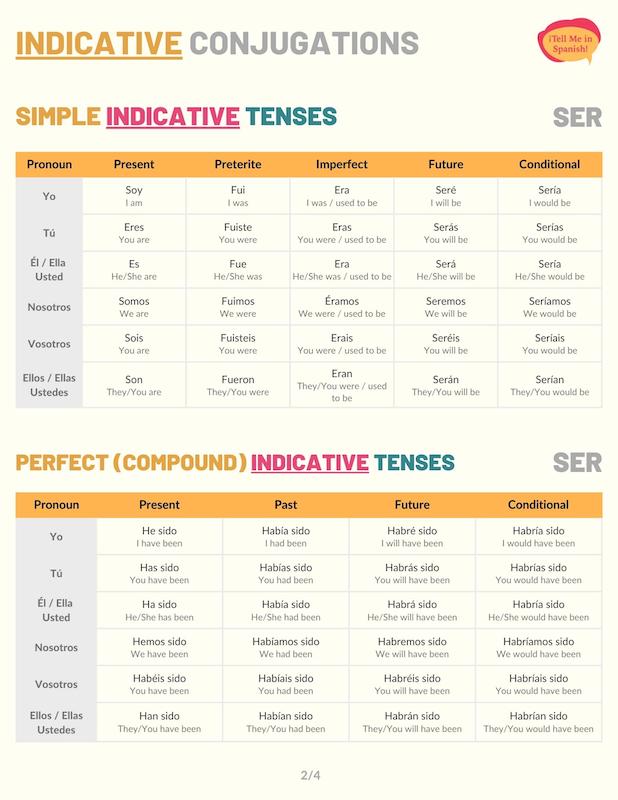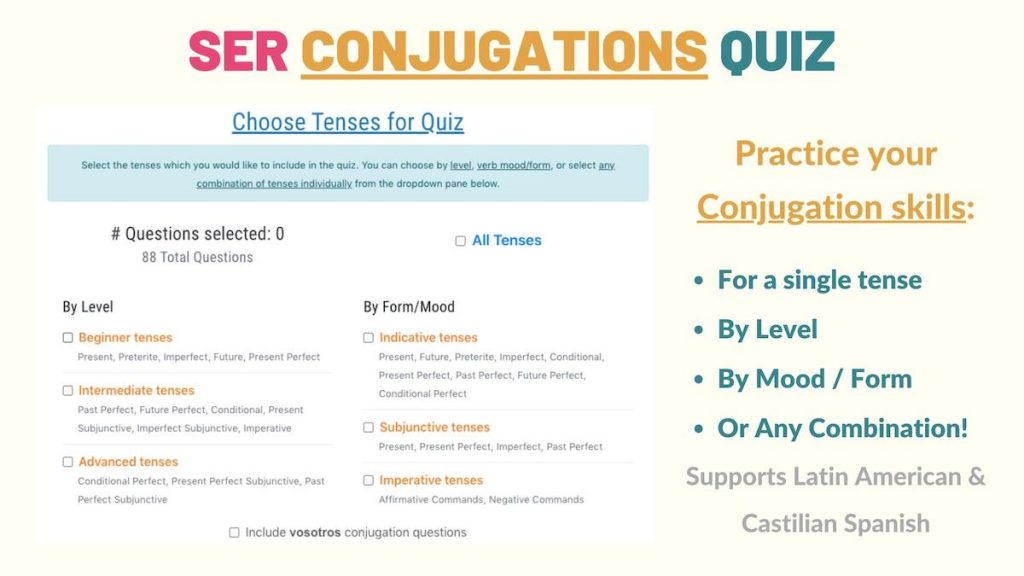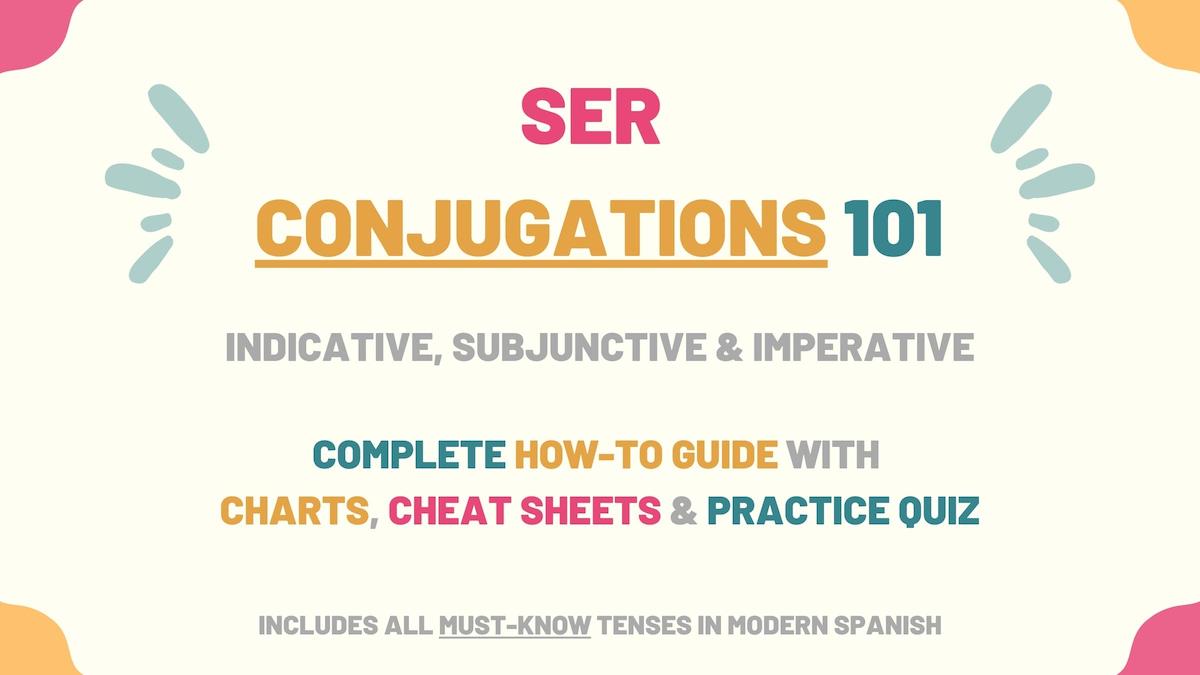Undoubtedly, ser is one of the most basic -ER verbs you’ll use in Spanish. However, this verb is irregular in the majority of tenses. So, to help you familiarize yourself, we’ll go over ser conjugation charts in this guide. Here’s a quick overview of what you’ll learn:
- Ser Overview
- Indicative Tenses of Ser Conjugations
- Subjunctive Tenses of Ser Conjugations
- Imperative (Commands) of Ser Conjugations
- Uses & Examples
- Download Ser Conjugation Tables & Uses Cheat sheets
- Ser Conjugation Practice Quiz
Overview of Ser
| Verb Characteristic | Property |
|---|---|
| Verb Type | -ER |
| Irregular | Yes |
| Infinitive | Ser |
| Gerund (Present Participle) Form | Siendo |
| Past Participle Form | Sido |
| Synonyms | N/A |
Irregularities:
- Present: soy for ‘yo’; e for ‘tú’, ‘él/ella’, and ‘usted’, so for the remaining pronouns.
- Preterite: fui for ‘yo’, ‘tú’, ‘nosotros’, and ‘vosotros’; fue for the third person singular and plural.
- Imperfect Indicative: era for all subject pronouns.
- Present Subjunctive: se for all subject pronouns.
- Imperfect Subjunctive: fue for all subject pronouns.
- Affirmative Imperative: sé only for ‘tú’, se for ‘usted’ and ‘ustedes’.
- Negative Imperative: se for all subject pronouns.
Indicative Conjugations of Ser
Present tense
The present tense conjugations of ser are irregular for all subject pronouns. Use the stem ‘so’ to conjugate the forms ‘yo’, ‘nosotros’, ‘vosotros’, and the third person plural. ‘Tú’ and the third person singular do not use this stem. You can check the present forms of ser in the conjugation chart below.
Conjugate ser to the present tense to talk about family relationships, nationality, physical descriptions, profession, or to tell the time in the present. For instance: Ellas son mis primas.
| Person | Conjugation | Translation |
|---|---|---|
| Yo | Soy | I am |
| Tú | Eres | You are |
| Él / Ella Usted | Es | He/She is You (formal) are |
| Nosotros | Somos | We are |
| Vosotros | Sois | You are |
| Ellos / Ellas Ustedes | Son | They are You (plural) are |
Preterite tense
Ser preterite conjugation has two irregular patterns. The pronouns ‘yo’, ‘tú’, ‘nosotros’, and ‘vosotros’ use the irregular stem fui, while the third person singular and plural use fue. When conjugated to the preterite past tense, this verb can be used to describe how a person was at a specific moment in the past.
For example: ¿Por qué fuiste tan grosera con Rachel?
| Person | Conjugation | Translation |
|---|---|---|
| Yo | Fui | I was |
| Tú | Fuiste | You were |
| Él / Ella Usted | Fue | He/She was You (formal) were |
| Nosotros | Fuimos | We were |
| Vosotros | Fuisteis | You were |
| Ellos / Ellas Ustedes | Fueron | They were You (plural) were |
Imperfect tense
Ser conjugations are also irregular in the past imperfect tense. To form this tense, we must use the stem era for all subject pronouns. Use ser imperfect conjugations to describe how people or things used to be, tell the time in the past or to talk about past relationships or things you used to own.
For instance: Eran las 11 cuando Juan llegó.
| Person | Conjugation | Translation |
|---|---|---|
| Yo | Era | I was I used to be |
| Tú | Eras | You were You used to be |
| Él / Ella Usted | Era | He/She was He/She used to be You (formal) were You (formal) used to be |
| Nosotros | Éramos | We were We used to be |
| Vosotros | Erais | You were You used to be |
| Ellos / Ellas Ustedes | Eran | They were They used to be You (plural) were You (plural) used to be |
Near future
The Spanish near future is formed with ir (present) + a + ser (infinitive). These conjugations are used to communicate what a person or thing is going to be in the future. This can include profession, family relationships, or personality traits. You can also use them to tell the time in the future.
For example: Julie y Aaron van a ser papás.
| Person | Conjugation | Translation |
|---|---|---|
| Yo | Voy a ser | I’m going to be |
| Tú | Vas a ser | You’re going to be |
| Él / Ella Usted | Va a ser | He/She is going to be You (formal) are going to be |
| Nosotros | Vamos a ser | We’re going to be |
| Vosotros | Vais a ser | You’re going to be |
| Ellos / Ellas Ustedes | Van a ser | They’re going to be You (plural) are going to be |
Future simple tense
Ser future conjugations are regular. You only must add the future endings as shown in the conjugation chart below. Conjugate ser to the future to communicate what people or things will be at some point in the future. Serás una excelente doctora.
| Person | Conjugation | Translation |
|---|---|---|
| Yo | Seré | I will be |
| Tú | Serás | You will be |
| Él / Ella Usted | Será | He/She will be You (formal) will be |
| Nosotros | Seremos | We will be |
| Vosotros | Seréis | You (formal) will be |
| Ellos / Ellas Ustedes | Serán | They will be You (plural) will be |
Conditional tense
The conditional conjugations of ser are also regular. Use these ‘ser’ forms to communicate what people or things would be if a circumstance is met. For instance: Si viviera en la playa, Anna sería muy feliz.
| Person | Conjugation | Translation |
|---|---|---|
| Yo | Sería | I would be |
| Tú | Serías | You would be |
| Él / Ella Usted | Sería | He/She would be You (formal) would be |
| Nosotros | Seríamos | We would be |
| Vosotros | Seríais | You would be |
| Ellos / Ellas Ustedes | Serían | They would be You (plural) would be |
Present perfect tense
Haber in the present tense + sido (past participle) is the formula to conjugate the present perfect in Spanish. These conjugations of ‘ser’ express what or how someone or something has or hasn’t been. For instance: Damian y Lucy han sido novios durante dos años.
| Person | Conjugation | Translation |
|---|---|---|
| Yo | He sido | I have been |
| Tú | Has sido | You have been |
| Él / Ella Usted | Ha sido | He/She has been You (formal) have been |
| Nosotros | Hemos sido | We have been |
| Vosotros | Habéis sido | You have been |
| Ellos / Ellas Ustedes | Han sido | They have been You (plural) have been |
Past perfect
Conjugate ser to the past perfect tense when you want to describe what or how someone had been before another action or point in the past. For example: Tom nunca había sido rechazado hasta este momento.
To conjugate to the past perfect, use the imperfect form of ‘haber’ and the past participle form of ‘ser’.
| Person | Conjugation | Translation |
|---|---|---|
| Yo | Había sido | I had been |
| Tú | Habías sido | You had been |
| Él / Ella Usted | Había sido | He/She had been You (formal) had been |
| Nosotros | Habíamos sido | We had been |
| Vosotros | Habíais sido | You had been |
| Ellos / Ellas Ustedes | Habían sido | They had been You (plural) had been |
Future perfect
Ser conjugated to the future perfect tense describes how people or things will have been by or before a certain moment in the future. These conjugations of ‘ser’ are also used to talk about how someone might have been. For example: ¿Por qué habré sido tan impulsivo cuando era joven?
| Person | Conjugation | Translation |
|---|---|---|
| Yo | Habré sido | I will have been |
| Tú | Habrás sido | You will have been |
| Él / Ella Usted | Habrá sido | He/She will have been You (formal) will have been |
| Nosotros | Habremos sido | We will have been |
| Vosotros | Habréis sido | You will have been |
| Ellos / Ellas Ustedes | Habrán sido | They will have been You (plural) will have been |
Conditional perfect
When conjugated to the Spanish conditional perfect tense, ser communicates how someone or something would have been if a past condition was met. For example: Michael nunca habría sido un buen escritor.
| Person | Conjugation | Translation |
|---|---|---|
| Yo | Habría sido | I would have been |
| Tú | Habrías sido | You would have been |
| Él / Ella Usted | Habría sido | He/She would have been You (formal) would have been |
| Nosotros | Habríamos sido | We would have been |
| Vosotros | Habríais sido | You would have been |
| Ellos / Ellas Ustedes | Habrían sido | They would have been You (plural) would have been |
Progressive tenses
In Spanish, the progressive tenses of ser express how someone or something is being at the moment of speaking. This usually refers to behavior or personality traits. For instance: Ustedes están siendo muy groseros. The progressive tenses are formed with estar + siendo (present participle).
| Progressive Tense | Formula | Translation Example |
|---|---|---|
| Present | Estar (present) + siendo | I am being |
| Preterite | Estar (preterite) + siendo | You were being |
| Imperfect | Estar (imperfect) + siendo | She was being |
| Future | Estar (future) + siendo | We will be being |
| Conditional | Estar (conditional) + siendo | They would be being |
Ser Subjunctive Conjugations
In Spanish, the subjunctive mood is used to discuss wishes, requests, suggestions, expectations, doubts, or hypothetical situations. Below are ser conjugation charts for the most common subjunctive tenses. Be aware that, in this mood, ser is also irregular.
Present subjunctive
Ser subjunctive conjugations are formed with the stem se. Use the subjunctive forms of this verb to express requests, wishes, expectations, or suggestions related to a person or thing being a certain way. For example: Los papás de Julia quieren que sea doctora.
| Person | Conjugation | Translation |
|---|---|---|
| Yo | Sea | I am |
| Tú | Seas | You are |
| Él / Ella Usted | Sea | He/She is You (formal) are |
| Nosotros | Seamos | We are |
| Vosotros | Seáis | You are |
| Ellos / Ellas Ustedes | Sean | They are You (plural) are |
Present perfect subjunctive
Ser in the present subjunctive + sido is the structure we use to conjugate ‘ser’ to the present perfect subjunctive. We use these conjugations to wonder or wish that a person or thing has been a certain way. Espero que no hayan sido groseros con la señora.
| Person | Conjugation | Translation |
|---|---|---|
| Yo | Haya sido | I have been |
| Tú | Hayas sido | You have been |
| Él / Ella Usted | Haya sido | He/She has been You (formal) have been |
| Nosotros | Hayamos sido | We have been |
| Vosotros | Hayáis sido | You have been |
| Ellos / Ellas Ustedes | Hayan sido | They have been You (plural) have been |
Imperfect subjunctive
The imperfect subjunctive conjugations of ‘ser’ allow you to talk about past suggestions, requests, beliefs, or wishes someone had about a person or thing being a certain way. For example: No creí que fuera tan tarde.
The imperfect subjunctive has two conjugation models depending on the type of Spanish you use.
Latin American Spanish version
| Person | Conjugation | Translation |
|---|---|---|
| Yo | Fuera | I was |
| Tú | Fueras | You were |
| Él / Ella Usted | Fuera | He/She was You (formal) were |
| Nosotros | Fuéramos | We were |
| Ellos / Ellas Ustedes | Fueran | They were You (plural) were |
Note: Latin American Spanish doesn’t use the pronoun vosotros. As a result, this pronoun has been excluded from ser’s conjugation chart above.
Castilian Spanish version
| Person | Conjugation | Translation |
|---|---|---|
| Yo | Fuese | I was |
| Tú | Fueses | You were |
| Él / Ella Usted | Fuese | He/She were You (formal) were |
| Nosotros | Fuésemos | We were |
| Vosotros | Fueseis | You were |
| Ellos / Ellas Ustedes | Fuesen | They were You (plural) were |
Past perfect subjunctive
In the past perfect subjunctive, ser expresses how someone or something would have been if a past circumstance was met. You can also use these conjugations to express regret or hypothesize about how things or people would have been.
Here is an example: Creo que hubieras sido un excelente maestro.
| Person | Conjugation | Translation |
|---|---|---|
| Yo | Hubiera sido | I had been |
| Tú | Hubieras sido | You had been |
| Él / Ella Usted | Hubiera sido | He/She had been You (formal) had been |
| Nosotros | Hubiéramos sido | We had been |
| Vosotros | Hubierais sido | You had been |
| Ellos / Ellas Ustedes | Hubieran sido | They had been You (plural) had been |
Ser Imperative Conjugations
In Spanish, to command people to do something, we must use the imperative conjugations of a verb.
Affirmative commands
Ser affirmative command conjugations are formed with the stem se. Use these commands to order people to be a certain way or pursue a profession. For example: Sean buenos con su mamá.
| Person | Conjugation | Translation |
|---|---|---|
| Tú | Sé | Be |
| Usted | Sea | Be |
| Vosotros | Sed | Be |
| Ustedes | Sean | Be |
Take Note: Notice that the affirmative command for ‘tú’ has an accent mark. This is done to distinguish this conjugation from the Spanish pronoun se.
Negative commands
If instead, you want to command people not to be a certain way, you must conjugate ser to the negative imperative. As shown in the conjugation chart below, these forms are the same as the present subjunctive.
Here is an example: ¡No seas ridícula!
| Person | Conjugation | Translation |
|---|---|---|
| Tú | No seas | Don’t be |
| Usted | No sea | Don’t be |
| Vosotros | No seáis | Don’t be |
| Ustedes | No sean | Don’t be |
Meanings of Ser & Examples
Now that you know how to conjugate ser in Spanish, you should check the following examples to have a better idea of the applications of this verb. Keep in mind that this guide focuses more on conjugation rather on how to use ser.
In simple terms, we use ser to tell the time in Spanish, express possession or relationships and describe people or objects. These descriptions range from physical and personality traits to nationality and profession.
[Ser conjugated] + [complement]
¿Qué hora era cuando Martha llegó?
What time was it when Martha arrived?
No sabía que este carro fuera tuyo.
I didn’t know that this car was yours.
Antonio y Anna han sido novios desde hace dos años.
Antonia and Anna have been dating for two years.
Download Ser Conjugation Tables & Uses Cheat sheets

Ser is one of the most important verbs and it’s an irregular -ER verb. It requires time to master and memorize all of its conjugations and uses. So, I’ve created a PDF you can download with all of ser’s conjugation charts and uses.
Practice Quiz: Ser Conjugation

Now that you’ve learned how to conjugate ser in Spanish, you can put your knowledge to practice by taking the ser conjugation practice quiz.

